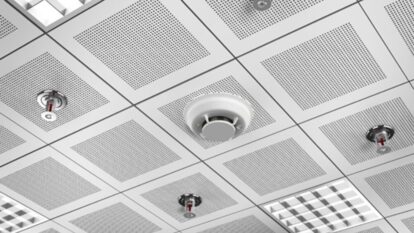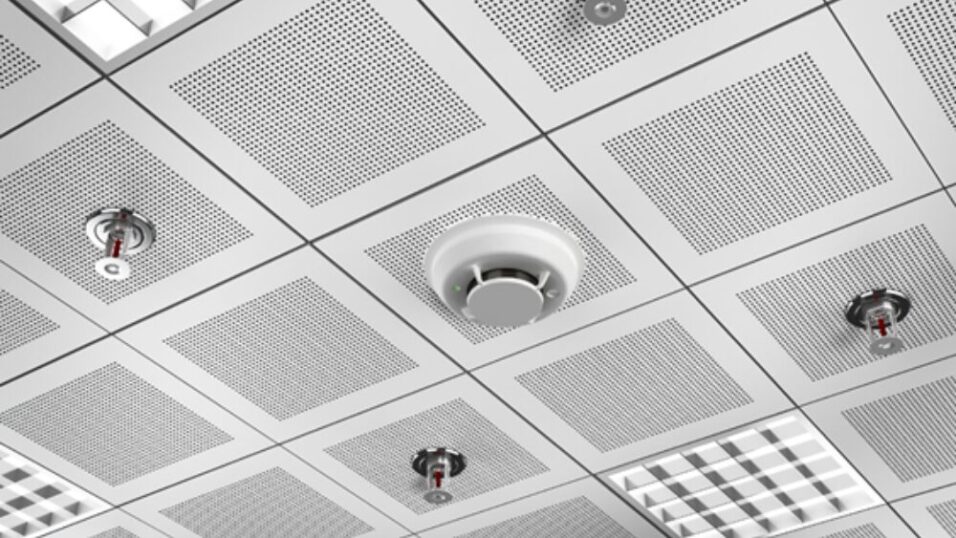



Smart Fire Alarms: Enhancing Safety with Connected Fire Systems
By Chubb | 14th October 2025
Fire safety is no longer limited to the familiar blaring sirens of traditional alarms. As buildings become more intelligent, so too must the systems that protect them. Enter smart fire alarms. Modern, connected fire safety devices that provide enhanced functionality, greater responsiveness and increased peace of mind for businesses and property owners alike.
Whether you’re managing a small retail space or a large commercial complex, smart fire systems offer a new level of safety by integrating cutting-edge technology with your building’s wider systems.
Understanding the Difference: Fire Detectors vs. Fire Alarms
Before we explore the benefits of smart fire alarms, it’s important to understand the distinction between fire detectors and fire alarms; two components that work hand in hand to keep people and property safe.
Fire detectors are the sensors that identify early signs of a fire, such as smoke, heat or flame. These sensors continuously monitor their environment for early signs of danger.
Fire alarms are the systems that respond when detectors are triggered. This may include audible sirens, visual strobes and smart notifications sent to key personnel or emergency services. Crucially, fire alarms can also be activated manually via manual call points – a vital component of any fire safety system. These devices allow the most adaptive and intelligent detectors of all – people, to act as the eyes and ears of the building, raising the alarm as soon as a threat is spotted.
While fire detectors are like the eyes and ears of a fire protection system, fire alarms act as the voice ensuring a swift response when fire prevention measures fall short. Early detection is critical, but it’s the alarm that initiates evacuation, activates suppression systems and helps coordinate emergency response.
Combine these two elements into a connected, responsive solution that can save lives and limit damage.
What Makes a Fire Alarm ‘Smart’?
A smart fire alarm connects to a network, often via WiFi or other IoT (Internet of Things) technology. This allows for real-time monitoring, remote notifications and system-wide integration with other safety infrastructure.
A smart fire alarm system can detect smoke or heat quickly and send instant alerts to mobile devices or central monitoring services. While some advanced systems can help reduce false alarms by recognising common non-threatening triggers, if smoke reaches the detector, the system will still generate an alarm to ensure safety is not compromised.
Key Benefits of Smart Fire Alarms
- Instant Remote Alerts
Building managers, tenants or security teams can receive notifications the moment smoke or heat is detected, whether they’re onsite or not. These alerts, typically sent via mobile apps, email or connected platforms, enable faster distribution of information, allowing teams to assess the situation remotely and begin investigation immediately. This early insight can help speed up decision-making, coordinate with emergency services more effectively and potentially prevent escalation.
- Integration with Smart Building Ecosystems
A smart fire alarm can seamlessly integrate with wider building management systems, including access control, emergency lighting, HVAC and sprinklers. In the event of an emergency, these systems can work together to help guide occupants to safety and limit fire spread.
- Reduced False Alarms
While no detector can identify the exact source of smoke, smart fire detection systems are designed to better interpret environmental conditions and reduce unwanted alarms. Technologies such as multi-sensor detectors, which combine heat and smoke sensing, help improve decision-making by analysing more than one variable before triggering an alarm.
- Scalable, Wireless Installation
Wireless smoke detectors offer an easier and more flexible installation process, particularly in large or complex buildings. With no need for extensive cabling, they can be easily added, repositioned or scaled as your building evolves.
Exploring Your Options: From Point Detection to Systems Monitoring
There are a number of different smart fire detection systems available; some more suitable than others depending on your building type and needs.
- Point Detection
Smoke and heat detectors can provide precise identification of a fire’s location. Smoke detectors are highly sensitive and best suited for areas where smoke or steam is not typically present, while heat detectors are ideal for environments like kitchens where smoke is common and could otherwise trigger false alarms. Multi-sensor detectors, which combine both smoke and heat sensing, offer increased accuracy and reduced false alerts. Chubb supplies a wide range of point detectors from leading manufacturers to meet specific building needs.
- Aspirating Smoke Detection
This highly sensitive system samples air through a network of pipes to detect smoke at its earliest stage, even before it’s visible. Ideal for high-value or mission-critical sites like data centres and server rooms, aspirating smoke detection systems are a powerful choice where early intervention is key. These systems can also be integrated with broader fire detection platforms for seamless performance.
- Beam Detection
Beam smoke detectors are ideal for large or open environments, such as warehouses, shopping centres or leisure venues, where traditional point detectors may be impractical. These systems detect smoke over long distances by using infrared sources to analyse obstructions across large open-air spaces.
Chubb offers two main types:
End-to-End Beam Detectors: Cost-effective but can be disrupted by structural obstructions.
Reflective Beam Detectors: Self-aligning and capable of automatically adjusting to building movement, offering a more reliable and intelligent alternative for challenging environments.
- Fire Detection System Monitoring
Beyond installation, Chubb can provide 24/7 fire alarm system monitoring, ensuring rapid response and constant oversight. Combined with regular maintenance and support services, this helps businesses meet compliance with confidence and focus on what they do best.
| Detection Type | Best For | Key Advantage |
| Point Detection | Offices, corridors, kitchens | Early warning of smoke that would otherwise compromise escape routes |
| Aspirating Detection | Data centres, server rooms | Ultra-early warning before visible smoke |
| Beam Detection | Warehouses, leisure centres | Wide-area coverage, fewer units needed |
| System Monitoring | All commercial premises | 24/7 response and peace of mind |
Future-Proofing Fire Safety
As fire risks evolve and expectations for building safety rise, businesses must consider smarter solutions that go beyond compliance. Investing in smart detectors or a fully connected fire alarm system not only enhances safety but also delivers operational efficiency and confidence for stakeholders.
Chubb is at the forefront of smart fire detection, offering tailored solutions that help customers protect people, property, assets and provide peace of mind.
Need help choosing the right smart fire alarm for your building?
Our experts at Chubb can advise you on the best system for your premises, whether you need wireless detectors, early warning systems or full-service monitoring.
Contact us today or explore our fire detection solutions.
© 2025 Chubb Fire and Security. All rights reserved.
The information provided in this blog is for general informational purposes only and does not constitute professional advice. Chubb Fire and Security is not responsible for any actions taken based on the information provided. This blog is not an advertisement or advice document. You are responsible for complying with any legal or regulatory requirements that apply to you.
Chubb Fire and Security reserves the right to modify the content and offers mentioned in this blog without prior notice.
 Global network
Global network
